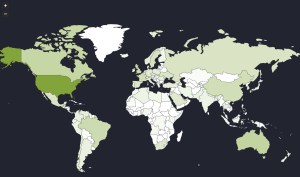Podcast: Play in new window | Download
Today, we’re discussing threats and errors inside business aviation operations that can eat away safety margin and expose private jet principals and passengers to unnecessary risk. To help us, we’re joined by author, speaker, and aviation safety advocate, Shannon Forest. He’s here to identify and handle these sometimes silent threats/errors lurking within our business aviation activities.
Different business sectors face factors that can brew quietly, then erode results quickly. Healthcare has infections, financials have data breaches, retail has recalls… inside each industry, inside each individual operation, people, policy, and processes bridge the threat/error gap between success and failure.
Business aviation is especially sensitive to threats/errors, physically and financially.
But, what do they look like and how do we defend against them in our business jet ventures?
Shannon Forest has some answers. He’s lead over 100 aviation workshops on human factors, standardization, and threat/error management for Fortune 500 flight departments, charter operators, business jet manufacturers, and the USAF. He was manager of CRM and Aviation Human Factors at FSI, serves as an FAA Gold Seal flight instructor (since 1991), is a graduate of the NTSB accident investigation course, holds degree in behavioral psychology, and has over 10,000 flight hours including operations in Challengers, Gulfstreams, and Airbus aircraft. Welcome to the show, Shannon.
Facing Threat/Error Brutal Facts
Jim Collins, the “Good to Great” guy, taught us that companies who face the brutal facts of their situation improve their chances of becoming/remaining great. Business aviation brings its own “brutal facts factors” termed threats and errors. And, to be great private aviation users (max safety, min. risk, considering economic value), we have to face them.
So, what is threat/error management? Shannon shares, “…it’s a paradigm, a way of dealing with human factors issues… a threat is anything that can impact the business aviation safety margins of the situation… and that must be addressed for those safety margins to be maintained.”
For instance, are you flying to your mountain town getaway (read Aspen, Vail, Park City), the high terrain surrounding your favorite winter city is also a threat with the potential to penetrate your business aviation safety margins… i.e. flying into the mountain (think snowstorm, nighttime, tired pilots, etc.).
To rebalance the risk/safety scale, we introduce policy/procedure to mitigate threats. Using the above example, Shannon discusses how pilots might display terrain on their cockpit maps so they can see what’s ahead electronically (assuming your aircraft has this capability).
With the threat identified, it’s time to monitor for errors. For instance, while flying into your mountain home airport, pilots will maintain minimum altitudes until passing certain safety points. They error might be descending too early. But, with a threat/error management program in place, we’re able to identify that error and get the airplane out of an undesired state.
So, the steps are:
- 1) identify threats
- 2) discuss how threats will be mitigated
- 3) actively monitor for errors
- 4) avoid undesired state
As the principal or passenger, how do you ensure threat/error management is active within your operation? Shannon advises:
Whether you use an aircraft management company or hire a crew individually, you want to maintain some sort of a structured program and adherence to standard operating procedures.
Threats and Errors in Business Aviation
Complacency
Despite having ten, fifteen, or twenty thousand hours of experience guiding your business jet through the air, complacency can creep into operations and become a very real threat and induce errors.
Fatigue
Aircraft capabilities have surpassed human capabilities. Today, we can build airplanes that can reach any location on Earth with only one stop and fly across multiple time zones. Shannon advises:
Humans can’t keep up from a biological standpoint.
Automation
Remember the first airplane you flew on? Remember looking into the cockpit and seeing, what seemed like, thousands of dials, switches, and levers? Those days are gone. Today’s aircraft are highly computerized and automated… which as dramatically improved safety. However, within recent years the “safety/technology progress curve” has begun to level off and, in some instances, begun to decline. We want to managed automation…
To increase situational awareness and reduce workload, not the other way around.
These threats/errors can exist at different levels, depending on your use of business aircraft and aviation. For example, six-passenger Citation Jets are likely impacted by threats/errors differently than longer-range, ten-passenger Falcon Jets than super-long range fifteen passenger Gulfstream Jets. Both equipment and missions brew differing levels of threats and errors. But, the threat/error management process remains consistent across all business aviation platforms.
Private Flying Goal: Zero Surprises
Business aviation principles and passengers ultimately expect one thing: zero surprises. Considering the most probable threats and errors lurking within private jet operations, the question we must ask is:
How do we avoid these threats and errors?
Solutions include:
- Open-channel dialogue with crews / management companies. Communicate.
- Establishing a “Just Culture.” Share Responsibility.
- Ensuring all buzzwords are backed up by action. Daily Discipline.
- Using industry best practices for staffing, training, P&P. Continuously Improve.
Takeaway
Families, Sports, Business… and business aviation share a commonality. Success starts at the top. The parents raise outstanding kids and contributors to society. The team owner supports coaches and players making the playoffs, Super Bowl, or olympics. The CEO drives high-margin results without sacrificing core values. Business aviation achieves safety and efficiency goals.
What’s the commonality? It all starts at the top. Ultimately, successful business aviation outcomes rest with you, the owners and operators. This industry stands by, ready to help!
Mentioned In The Show
Shannon Forrest – Turbine Mentor Website (including contact info.)
Comments
How do you manage threats and errors in your business aviation ventures?
Share your experience / feedback in the comments below, or confidentially here.
Subscribe in iTunes | Give an iTunes Rating (here’s how)





